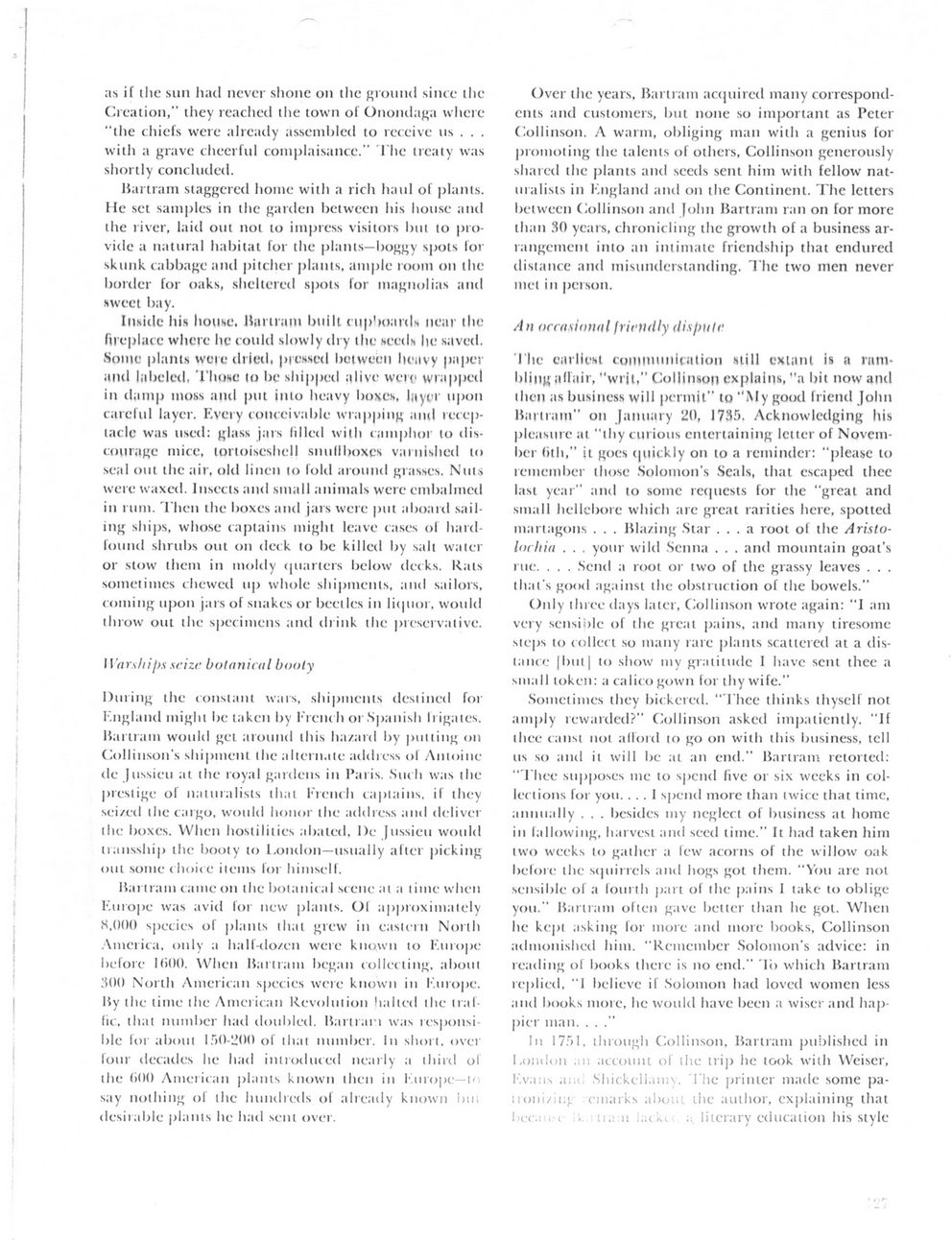This text was obtained via automated optical character recognition.
It has not been edited and may therefore contain several errors.
as if the sun had never shone on the ground since the Creation,? they readied the town of Onondaga where ?the chiefs were already assembled to receive us . . . with a grave checrful complaisance.? The treaty was shortly concluded.
Bartram staggered home with a rich haul of plants. He set samples in the garden between his house and the river, laid out not to impress visitors bin to provide a natural habitat for the plants?boggy spots for skunk cabbagc and pitcher plants, ample room on the border for oaks, sheltered spots for magnolias and sweet bay.
Inxidc his house. Bartram built cupboards near the fireplace where lie could slowly dry the seeds lie saved. Some plants were dried, pressed between henvy paper and labeled, Those to be shipped alive were wrapped in damp moss anil put into heavy boxes, layt:r upon careful layer. Every conceivable wrapping and receptacle was used: glass jars filled with camphor to discourage mice, tortoiseshell snullboxcs varnished to seal out the air, old linen to fold around grasses. Nuts were waxed. Insects and small animals were embalmed in rum. Then the boxes and jars were put aboard sailing ships, whose captains might leave cases of hard-found shrubs out 011 deck to be killed by salt water or stow them in moldy quarters below decks. Rats sometimes chewed up whole shipments, and sailors, coming upon jars of snakes or beetles in liquor, would throw out the specimens and drink the preservative.
11 'arshins seize botanical booty
During the constant wars, shipments destined for Kngland might be taken by French or Spanish Irigatcs. Barli.im would gel around this hazard by putting on Colliuson's shipment the alternate address of Antoine de Jussieu at the royal gardens iu Paris. Such was the prestige of naturalists that French captains, if they sei/ed the cargo, would honor the address and deliver the boxes. When hostilities abated, I)e Jussieu would transship the booty to London?usually alter picking out some choice items for himself.
Bartram came 011 the botanical scene at a time when F.urope was avid for new plants. Of approximately
8,000 species of plants that grew in eastern North America, only a half-dozen were known to F.urope before I<?()(). When Hartram began collecting, about .?{00 North American species were known in F.urope. By the time the American Revolution halted the traffic. that number had doubled. Haitian was responsible for about l.r>0-200 of that number. In short, over four decades lie had introduced nearly a third of the (>00 American plants known then in F.urope?to say nothing of the hundreds of already known hu; desirable plants he had sent over.
Over the years, Bartram acquired many correspondents and customers, but none so important as Peter Collinson. A warm, obliging man with a genius for promoting the talents of others, Collinson generously shared the plants and seeds sent him with fellow naturalists in Fngland and 011 the Continent. The letters between Collinson and John Bartram ran 011 for more than 30 years, chronicling the growth of a business arrangement into an intimate friendship that endured distance and misunderstanding. The two men never met in person.
An occasional friendly dispute
The earliest cumtminUation still extant is a rumbling ;ilfair, "writ," Collinson explains, "a bit now and then as business will permit" to "My good friend John Bantam" on January 20, 1735. Acknowledging his pleasure at ?thy curious entertaining letter of November (ith,? it goes quickly 011 to a reminder: ?please to remember those Solomon?s Seals, that escaped thee last year? and to some requests for the ?great and small hellebore which are great rarities here, spotted martagons . . . Blazing Star ... a root of the Aristo-lochia . . . your wild Senna . . . and mountain goat?s rue. . . . Send a root or two of the grassy leaves . . . that's good against the obstruction of the bowels.? Only three days later, Collinson wrote again: "I am very sensible of the great pains, and many tiresome steps to collect so many rare plants scattered at a distance |but) to show my gratitude I have sent thee a small token: a calico gown for thy wife.?
Sometimes they bickered. ?Thee thinks thyself not amply rewarded?" Collinson asked impatiently. ?If thee canst not afford to go 011 with this business, tell us so and it will be at an end.? Bartram retorted: ?Thee supposes me to spend five or six weeks in collections for you. ... I spend more than twice that time, annually . . . besides my neglect of business at home in fallowing, harvest and seed time.? It had taken him two weeks to gather a few acorns of the willow oak before the squirrels and hogs got them. ?You are not sensible of a fourth part of the pains I take to oblige you.? Hartram often gave better than he got. When he kept asking for more and more books, Collinson admonished him. ?Remember Solomon?s advice: in reading of books there is 110 end.? 'Ib which Bartram replied, ?I believe if Solomon had loved women less and books more, he would have been a wiser and happier man. . . .?
In 1751, through Collinson, Bartram published in London an account of the trip iie took with Weiser, F.vans and Sliickcllamy. The printer made some pa-
11 oiii/ii:j. cmarks about the author, explaining that lu-<\i . i ; IK! 11 ;; literary education his style

Bartram Smithsonian-article-re-John-Bartram-1977-p.7